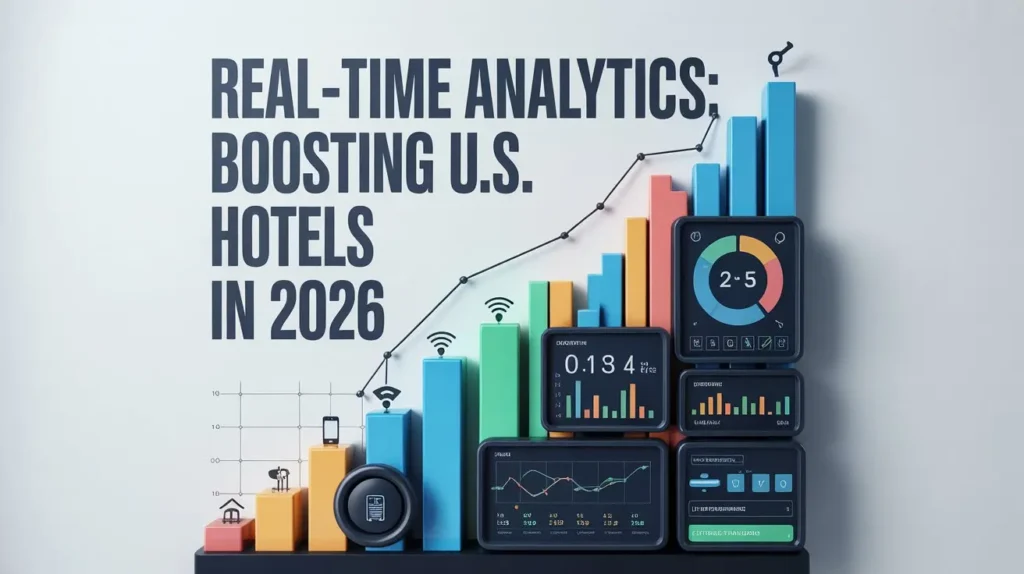In 2026 the hotels that win are those combining smart revenue strategy with real-time analytics. That combination lets teams price correctly for shifting demand, sell the right ancillary offers at the right moment, and react quickly to market shocks. The last few years showed that travel demand can change fast and unpredictably. Hotels that rely on slow monthly reports and manual price changes risk leaving revenue on the table.
Real-time tools and automated decision systems are now essential for protecting margin, improving RevPAR and maximizing occupancy across city, resort and suburban markets. This article explains why real-time analytics matters, what capabilities you need, how to implement a practical plan for U.S. hotels, and what to watch for in 2026.
Why real-time analytics matters now for U.S. hotels
Faster, evidence-based decisions
Real-time analytics changes the tempo of decision-making. Instead of relying on weekly or monthly historic reports, revenue teams can respond to minute-by-minute signals: booking pace, pick-up by channel, competitor rate moves, event or flight disruptions, and weather. Speed in decision-making converts directly into better pricing and higher conversion.
The business payoff
Modern revenue teams that combine real-time inputs with automated pricing engines have reported meaningful gains in ADR and total revenue. Vendor case studies show substantial, property-level uplifts when dynamic pricing and targeted offers are implemented well. Those results confirm that speed plus signal quality drives value.
U.S. market context
In the U.S., RevPAR growth moderated in 2025 and booking windows shortened. That environment makes real-time monitoring and rapid reaction a priority. When demand is volatile, real-time analytics protects revenue and helps capture upside when demand surges.
Core capabilities of a real-time analytics revenue stack
To make real-time analytics actionable you need several core capabilities working together. Below are the essentials.
1. Live data ingestion
Collect booking pace, cancellations, channel pick-up, OTA rates, competitor parity, group pick-up, local events and weather into a live data pipeline. Low-latency data is the foundation of effective real-time decisions.
2. Unified data layer
Combine PMS, CRS, POS, CRM and channel manager data into a single view. A unified layer is what lets pricing engines and personalization systems act on complete guest and inventory context.
3. Dynamic pricing engine
Use a rules-based plus machine-learning pricing engine that proposes or sets rates in real time, based on demand signals, competitor pricing and property objectives.
4. Real-time dashboards and alerts
Provide simple, focused dashboards for revenue managers and operations that show pick-up, pace vs forecast, channel health and suggested actions. Alerts should trigger on anomalies so teams can act quickly.
5. Testing and measurement
Include A/B testing and attribution so you can measure lift from price moves, promotions and ancillary campaigns. Testing separates real impact from noise.
6. Integration with distribution and CRM
Automate offer delivery (email, app, upsell at booking) so personalized offers convert before arrival and increase ancillary revenue.
How real-time analytics drives revenue: four direct levers
1. Faster, smarter pricing
Shorter booking windows demand price moves by the hour rather than by the day. Real-time engines adjust pricing dynamically to protect margin during surges and stimulate demand during slow periods.
2. Improved channel mix
By tracking channel conversion in real time, managers can allocate inventory and tailor rates or promotions toward channels that convert best and cost least. This improves net RevPAR.
3. Higher ancillary conversion and personalization
Real-time guest signals allow targeted offers for dining, spa, parking and experiences. Linking POS and guest history data increases conversion for those offers.
4. Operational optimization
Accurate, real-time forecasts help operations plan staffing and F&B provisioning, reducing waste and lowering costs while maintaining guest satisfaction.
Real, recent data hotels should know (U.S. context)
- Market growth: The revenue management and pricing analytics market is expanding rapidly as hotels adopt cloud, automation and real-time pricing tools. This trend is driven by the need to act faster and more precisely.
- Revenue uplift examples: Vendor case studies show single-property ADR uplifts when dynamic pricing and room-type strategies are applied. Use these examples to build conservative ROI models for your property.
- U.S. performance trends: 2025 brought mixed RevPAR results across segments and shorter booking windows, increasing the value of fast, data-driven revenue actions.
- Investment priorities: Surveys show hoteliers prioritize integration, AI and data as top 2025–2026 investments. Focus your business case on measured outcomes: ADR lift, ancillary revenue and reduced operational waste.
A practical 6-month plan for U.S. hotels (pilot to scale)
This phased plan helps implement real-time analytics without overcommitting capital or disrupting operations.
Month 0: Preparation and baseline
- Audit data sources: PMS, CRS, channel manager, POS, booking engine and CRM.
- Document data delays and integration gaps.
- Baseline KPIs for the prior 12 months: Occupancy, ADR, RevPAR, ancillary revenue per occupied room, cancellation rate, booking window.
Months 1–2: Quick-win pilots
- Implement a dynamic pricing pilot on a controlled room block or selected day-types. Start in recommendation mode so revenue managers review price suggestions.
- Set up a pick-up dashboard showing current pick-up vs forecast and competitor rate moves.
Months 3–4: Expand automation and connect channels
- Move selectively from recommendations to partial automation (for low-risk segments).
- Integrate POS to test in-app F&B offers and one-click upsells.
Months 5–6: Measure and scale
- Run A/B tests on pricing and ancillary offers to measure lift; set rules and confidence thresholds for automation.
- Establish daily operating cadence and automated alerts for overnight rate checks and parity exceptions.
Tools and vendor selection: what to prioritize in 2026
When selecting tools and vendors, prioritize the following criteria.
Real-time feed quality
Verify vendor claims about real time. Some platforms poll hourly — true real time is lower latency and more frequent sampling.
Integration capability
Open APIs and strong integration support with common PMS, POS, and channel managers are essential. Integration matters more than flashy dashboards.
Transparency and control
Choose vendors that explain pricing logic and offer rollback controls. Your team must be able to validate and trust automated recommendations.
Testing and rollback
Select systems with built-in experimentation and safe rollback options to avoid sustained negative outcomes from an automated change.
Compliance and support
For U.S. properties, ensure vendors meet security and compliance expectations and provide reliable regional support.
KPIs to track — daily, weekly and monthly
Daily
- Pick-up vs forecast by channel
- Channel conversion rates
- Competitor price parity exceptions
Weekly
- Booking window length by segment
- Ancillary revenue per occupied room
- OTA vs direct conversion trends
Monthly
- ADR, Occupancy, RevPAR
- Revenue by customer segment (corporate, leisure, group)
- Net RevPAR after commissions and fees
Always link KPI analysis to the action that will change it: price change, targeted offer, or distribution adjustment.
Market-specific considerations across U.S. geographies
Revenue behaviour varies by market; localize models accordingly.
Global gateway cities (NYC, L.A., SFO)
- Faster booking windows and greater volatility driven by corporate and international travel.
- Monitor flight disruptions, conventions and corporate calendars.
Secondary metros and regional business hubs
- More stable corporate patterns; integrate local calendars like college terms and regional event schedules.
Resort and leisure markets
- Seasonality and weather are primary demand drivers. Include weather and short-term leisure signals in models.
Suburban, economy and extended-stay
- Higher rate sensitivity and longer stays. Focus automation on occupancy and long-stay ancillaries.
Risks and guardrails
Over-automation
Keep automation within agreed rules and confidence thresholds to prevent unintended price swings.
Data quality issues
Prioritize clean guest profiles and accurate channel data before relying on automated decisions.
Price wars and parity
Monitor OTA parity and contractual obligations to avoid penalties and revenue leakage.
Guest perception
Too-visible price volatility can erode trust. Use loyalty perks and clear communication to protect relationships.
Security and compliance
Ensure vendors encrypt data and follow PCI and relevant U.S. privacy expectations. Document retention and consent policies.
Quick tactical tips you can apply today
- Shorten your revenue meeting cadence to daily 10-minute pick-up briefs during busy weeks.
- Push time-sensitive packages (F&B credits, late checkout) when pick-up is slow 7–14 days out.
- Protect margins on high-demand days with minimum length of stay and tailored restrictions for low-margin segments.
- Test mobile-first upsells at booking confirmation and again 48 hours before arrival.
- Tag every promotion and price move so you can attribute revenue impact precisely.
Frequently Asked Questions (FAQs)
- How much revenue lift can I expect from real-time pricing?
Results vary. Some case studies show substantial ADR uplifts at the property level. For planning, model a conservative single-digit RevPAR improvement in year one and scale from proven pilots. - Do I need a data scientist to use these tools?
Not necessarily. Many vendors provide prebuilt models and GUIs for revenue managers. You do need someone who understands data hygiene, KPI definitions and experimental design. - Are these tools affordable for independent hotels?
Cloud pricing and tiered SaaS models have made these tools more accessible. Start with a pilot product built for independents and expand based on ROI. - How do tools handle sudden demand shocks?
Top platforms detect anomalies and issue alerts. Define business rules that pause automation or widen decision thresholds during extreme volatility. - What compliance issues should U.S. hotels consider?
Ensure vendors use encrypted data practices, support PCI DSS for payments and can accommodate state-level privacy expectations. Keep guest consent and retention policies documented.
Conclusion
Real-time analytics and automated revenue strategy amplify human judgment and enable faster, more effective revenue decisions. For U.S. hotels facing shorter booking windows and higher volatility, these systems are essential for protecting revenue and capturing opportunities.
Begin with a data audit, run small pilots, measure lift rigorously and scale the systems that prove clear ROI. When speed, data quality and governance are aligned, real-time analytics becomes the competitive edge that defines 2026 winners.








